Comprehensive Analysis of Accounting Principles and Practices
VerifiedAdded on 2023/06/08
|17
|5276
|320
Report
AI Summary
This report provides a comprehensive analysis of accounting principles, including the purpose and scope of accounting in complex environments, its role in decision-making, and its ability to meet stakeholder needs. It explores the main branches of accounting, basic accounting concepts, and threats to business enterprises related to regulation, compliance, and ethics. The report includes the construction of a schedule of expected cash collections and disbursements, a cash budget, and a flexible budget. Furthermore, it prepares financial statements, computes liquidity, profitability, and investment ratios, and offers recommendations on the company's liquidity position and overall performance. The analysis is aimed at providing a thorough understanding of the company's financial standing and future prospects.
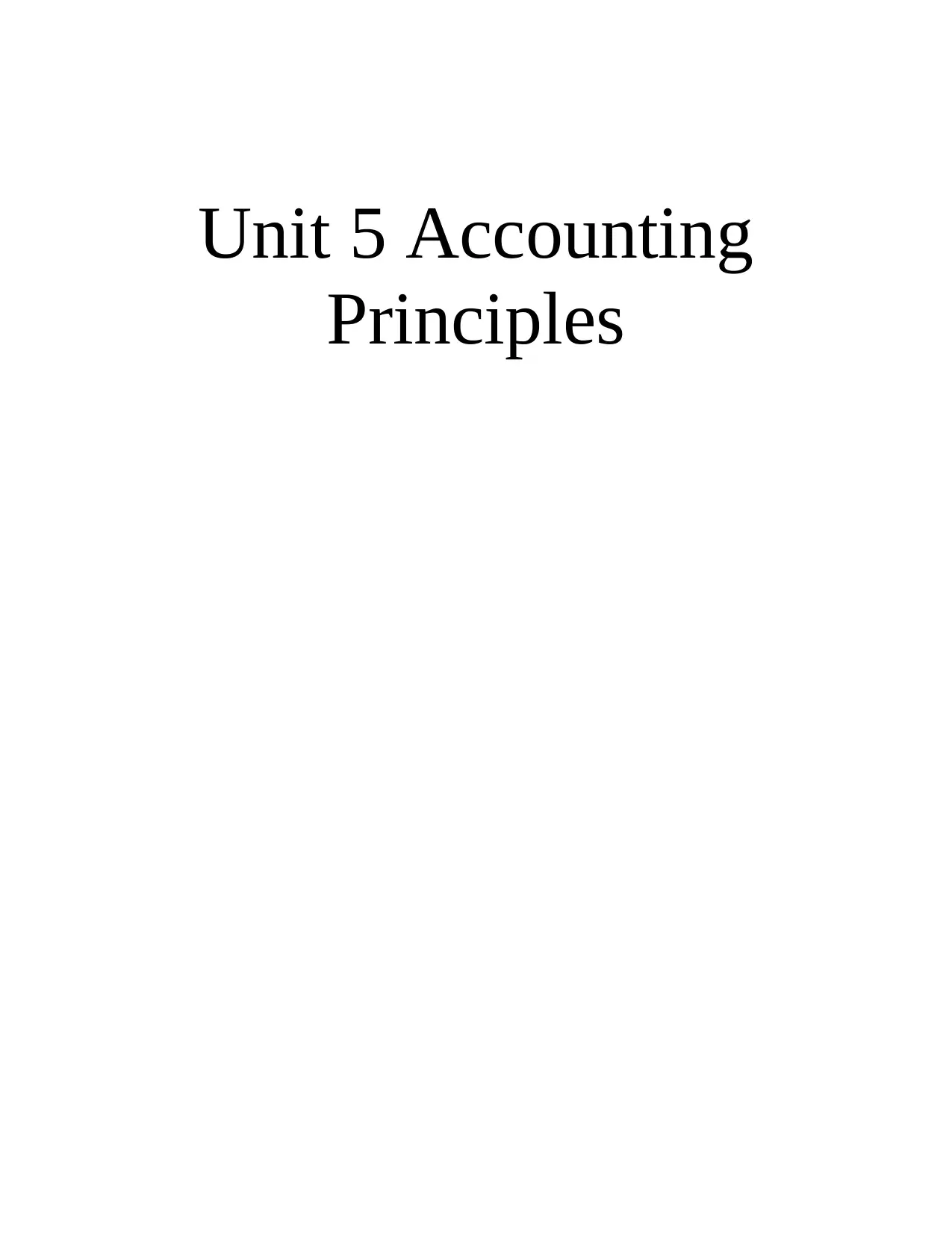
Unit 5 Accounting
Principles
Principles
Paraphrase This Document
Need a fresh take? Get an instant paraphrase of this document with our AI Paraphraser
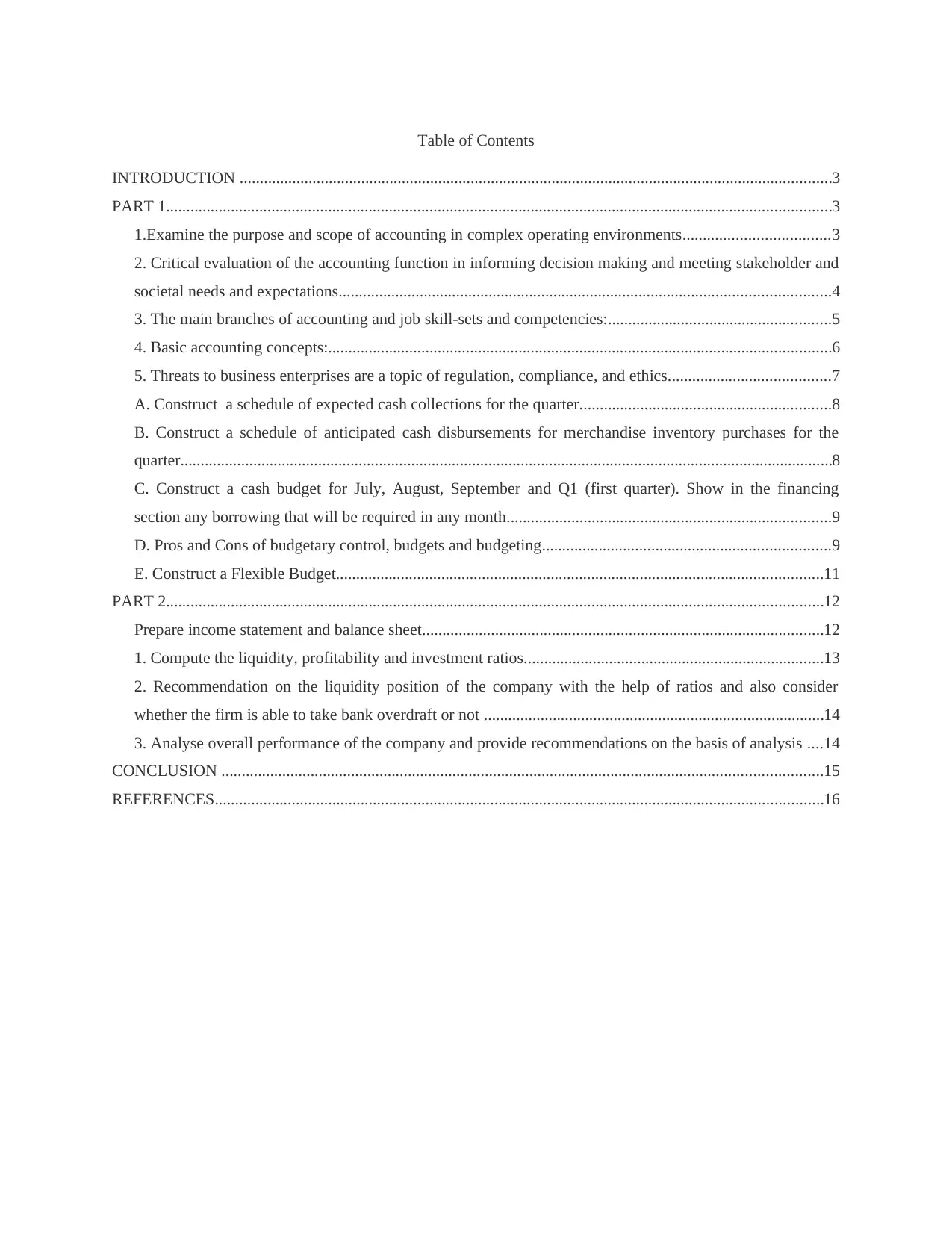
Table of Contents
INTRODUCTION ..................................................................................................................................................3
PART 1....................................................................................................................................................................3
1.Examine the purpose and scope of accounting in complex operating environments....................................3
2. Critical evaluation of the accounting function in informing decision making and meeting stakeholder and
societal needs and expectations.........................................................................................................................4
3. The main branches of accounting and job skill-sets and competencies:.......................................................5
4. Basic accounting concepts:............................................................................................................................6
5. Threats to business enterprises are a topic of regulation, compliance, and ethics........................................7
A. Construct a schedule of expected cash collections for the quarter..............................................................8
B. Construct a schedule of anticipated cash disbursements for merchandise inventory purchases for the
quarter.................................................................................................................................................................8
C. Construct a cash budget for July, August, September and Q1 (first quarter). Show in the financing
section any borrowing that will be required in any month................................................................................9
D. Pros and Cons of budgetary control, budgets and budgeting.......................................................................9
E. Construct a Flexible Budget........................................................................................................................11
PART 2..................................................................................................................................................................12
Prepare income statement and balance sheet...................................................................................................12
1. Compute the liquidity, profitability and investment ratios..........................................................................13
2. Recommendation on the liquidity position of the company with the help of ratios and also consider
whether the firm is able to take bank overdraft or not ....................................................................................14
3. Analyse overall performance of the company and provide recommendations on the basis of analysis ....14
CONCLUSION ....................................................................................................................................................15
REFERENCES......................................................................................................................................................16
INTRODUCTION ..................................................................................................................................................3
PART 1....................................................................................................................................................................3
1.Examine the purpose and scope of accounting in complex operating environments....................................3
2. Critical evaluation of the accounting function in informing decision making and meeting stakeholder and
societal needs and expectations.........................................................................................................................4
3. The main branches of accounting and job skill-sets and competencies:.......................................................5
4. Basic accounting concepts:............................................................................................................................6
5. Threats to business enterprises are a topic of regulation, compliance, and ethics........................................7
A. Construct a schedule of expected cash collections for the quarter..............................................................8
B. Construct a schedule of anticipated cash disbursements for merchandise inventory purchases for the
quarter.................................................................................................................................................................8
C. Construct a cash budget for July, August, September and Q1 (first quarter). Show in the financing
section any borrowing that will be required in any month................................................................................9
D. Pros and Cons of budgetary control, budgets and budgeting.......................................................................9
E. Construct a Flexible Budget........................................................................................................................11
PART 2..................................................................................................................................................................12
Prepare income statement and balance sheet...................................................................................................12
1. Compute the liquidity, profitability and investment ratios..........................................................................13
2. Recommendation on the liquidity position of the company with the help of ratios and also consider
whether the firm is able to take bank overdraft or not ....................................................................................14
3. Analyse overall performance of the company and provide recommendations on the basis of analysis ....14
CONCLUSION ....................................................................................................................................................15
REFERENCES......................................................................................................................................................16
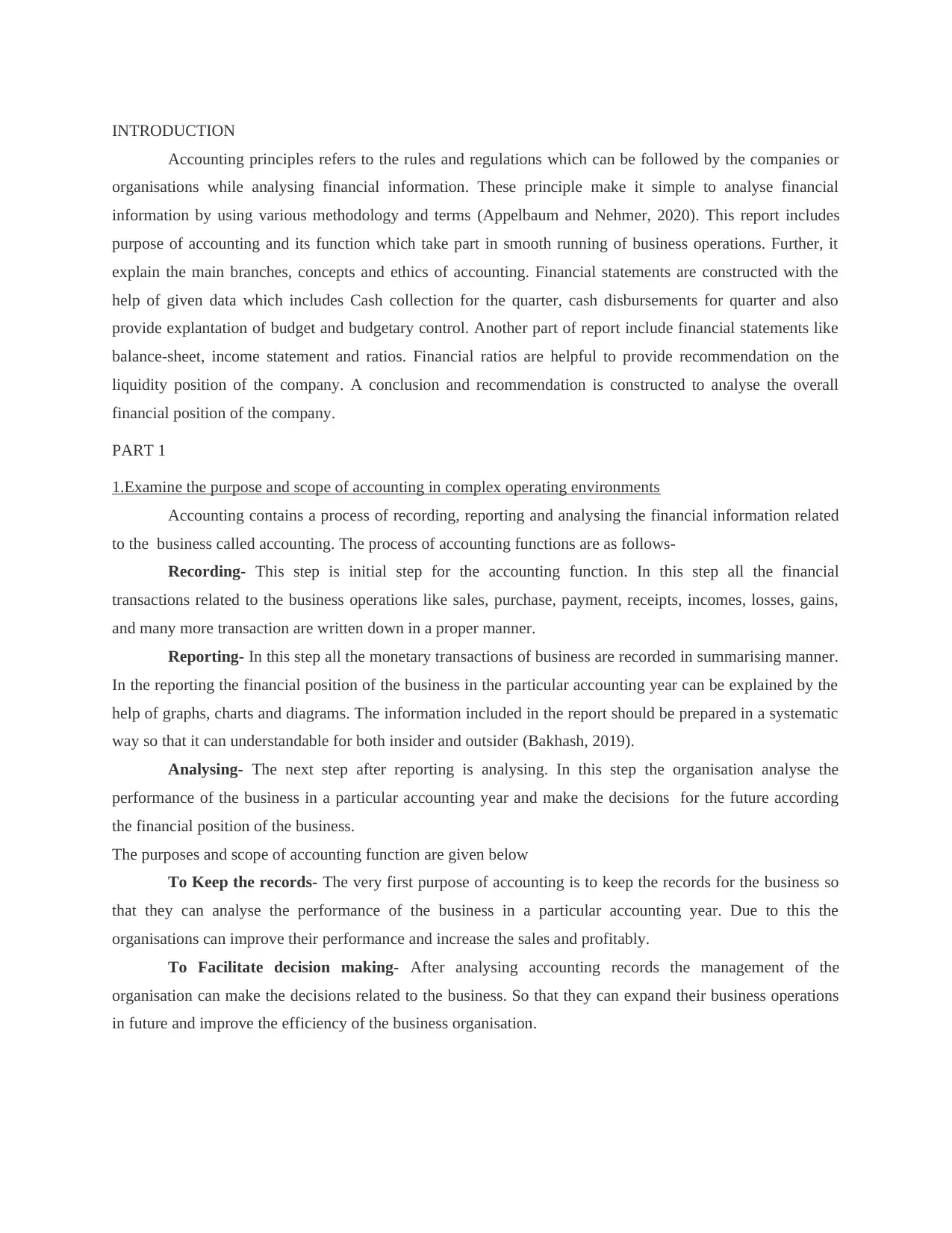
INTRODUCTION
Accounting principles refers to the rules and regulations which can be followed by the companies or
organisations while analysing financial information. These principle make it simple to analyse financial
information by using various methodology and terms (Appelbaum and Nehmer, 2020). This report includes
purpose of accounting and its function which take part in smooth running of business operations. Further, it
explain the main branches, concepts and ethics of accounting. Financial statements are constructed with the
help of given data which includes Cash collection for the quarter, cash disbursements for quarter and also
provide explantation of budget and budgetary control. Another part of report include financial statements like
balance-sheet, income statement and ratios. Financial ratios are helpful to provide recommendation on the
liquidity position of the company. A conclusion and recommendation is constructed to analyse the overall
financial position of the company.
PART 1
1.Examine the purpose and scope of accounting in complex operating environments
Accounting contains a process of recording, reporting and analysing the financial information related
to the business called accounting. The process of accounting functions are as follows-
Recording- This step is initial step for the accounting function. In this step all the financial
transactions related to the business operations like sales, purchase, payment, receipts, incomes, losses, gains,
and many more transaction are written down in a proper manner.
Reporting- In this step all the monetary transactions of business are recorded in summarising manner.
In the reporting the financial position of the business in the particular accounting year can be explained by the
help of graphs, charts and diagrams. The information included in the report should be prepared in a systematic
way so that it can understandable for both insider and outsider (Bakhash, 2019).
Analysing- The next step after reporting is analysing. In this step the organisation analyse the
performance of the business in a particular accounting year and make the decisions for the future according
the financial position of the business.
The purposes and scope of accounting function are given below
To Keep the records- The very first purpose of accounting is to keep the records for the business so
that they can analyse the performance of the business in a particular accounting year. Due to this the
organisations can improve their performance and increase the sales and profitably.
To Facilitate decision making- After analysing accounting records the management of the
organisation can make the decisions related to the business. So that they can expand their business operations
in future and improve the efficiency of the business organisation.
Accounting principles refers to the rules and regulations which can be followed by the companies or
organisations while analysing financial information. These principle make it simple to analyse financial
information by using various methodology and terms (Appelbaum and Nehmer, 2020). This report includes
purpose of accounting and its function which take part in smooth running of business operations. Further, it
explain the main branches, concepts and ethics of accounting. Financial statements are constructed with the
help of given data which includes Cash collection for the quarter, cash disbursements for quarter and also
provide explantation of budget and budgetary control. Another part of report include financial statements like
balance-sheet, income statement and ratios. Financial ratios are helpful to provide recommendation on the
liquidity position of the company. A conclusion and recommendation is constructed to analyse the overall
financial position of the company.
PART 1
1.Examine the purpose and scope of accounting in complex operating environments
Accounting contains a process of recording, reporting and analysing the financial information related
to the business called accounting. The process of accounting functions are as follows-
Recording- This step is initial step for the accounting function. In this step all the financial
transactions related to the business operations like sales, purchase, payment, receipts, incomes, losses, gains,
and many more transaction are written down in a proper manner.
Reporting- In this step all the monetary transactions of business are recorded in summarising manner.
In the reporting the financial position of the business in the particular accounting year can be explained by the
help of graphs, charts and diagrams. The information included in the report should be prepared in a systematic
way so that it can understandable for both insider and outsider (Bakhash, 2019).
Analysing- The next step after reporting is analysing. In this step the organisation analyse the
performance of the business in a particular accounting year and make the decisions for the future according
the financial position of the business.
The purposes and scope of accounting function are given below
To Keep the records- The very first purpose of accounting is to keep the records for the business so
that they can analyse the performance of the business in a particular accounting year. Due to this the
organisations can improve their performance and increase the sales and profitably.
To Facilitate decision making- After analysing accounting records the management of the
organisation can make the decisions related to the business. So that they can expand their business operations
in future and improve the efficiency of the business organisation.
⊘ This is a preview!⊘
Do you want full access?
Subscribe today to unlock all pages.

Trusted by 1+ million students worldwide

To Provide information to the investors- The next important purpose of accounting is that
it helps in providing the financial information to the investors so that they can invest their money
at the right place .
To Meets legal requirements- Accounting function provide all the financial data of the
business which helps them to find out the tax liability of the business. Due to this the
organisations can pay their tax on time and meet all the legal requirements. If the organisation
did not pay the taxes then it will consider as a legal offence and the owner of the organisation
can get into a prison of that activity. So that why this purpose is consider as a main purpose for
the organisation (Barabash and et.al., 2020).
2. Critical evaluation of the accounting function in informing decision making and meeting
stakeholder and societal needs and expectations
Accounting is very important of the organisation by the help of this function the
organisation can evaluate the financial position, goodwill and opportunities to earn the profit in
future for the firm. This function is not only good for the organisation it is also beneficial for the
society, investors and the competitors. The analysis and evaluation of the financial position of
the company can be done by the help of the financial statements of the business. The financial
statements include profit and loss account, balance sheet, cash flow, and notes to account. The
critical evaluation of the accounting helps in informing decision making and meeting stakeholder
and societal needs and expectations. The two types of accounting functions are given given
below.
Financial reporting- This function of accounting is mainly determined on providing the
information to the outside users like government and other authorities. But this financial
reporting function can also be used for internal organisation by help of making strategies for
increasing the sales and profitability of the organisations. This financial report contains the
information related to the operations of organisation like P&L statement, balance-sheet, cash
flow statement, accounts payable, notes to account and accounts receivable. These financial
reports helps the investors to evaluate the financial positions of the business so that they can
decide whether they have to invest in the business or not. It helps them to invest their money so
that they can earn some profit (Brink and et.al., 2020).
Management Reporting- This reporting function of accounting is more useful for the
organisation as compare to financial reporting. The management reporting function helps the
it helps in providing the financial information to the investors so that they can invest their money
at the right place .
To Meets legal requirements- Accounting function provide all the financial data of the
business which helps them to find out the tax liability of the business. Due to this the
organisations can pay their tax on time and meet all the legal requirements. If the organisation
did not pay the taxes then it will consider as a legal offence and the owner of the organisation
can get into a prison of that activity. So that why this purpose is consider as a main purpose for
the organisation (Barabash and et.al., 2020).
2. Critical evaluation of the accounting function in informing decision making and meeting
stakeholder and societal needs and expectations
Accounting is very important of the organisation by the help of this function the
organisation can evaluate the financial position, goodwill and opportunities to earn the profit in
future for the firm. This function is not only good for the organisation it is also beneficial for the
society, investors and the competitors. The analysis and evaluation of the financial position of
the company can be done by the help of the financial statements of the business. The financial
statements include profit and loss account, balance sheet, cash flow, and notes to account. The
critical evaluation of the accounting helps in informing decision making and meeting stakeholder
and societal needs and expectations. The two types of accounting functions are given given
below.
Financial reporting- This function of accounting is mainly determined on providing the
information to the outside users like government and other authorities. But this financial
reporting function can also be used for internal organisation by help of making strategies for
increasing the sales and profitability of the organisations. This financial report contains the
information related to the operations of organisation like P&L statement, balance-sheet, cash
flow statement, accounts payable, notes to account and accounts receivable. These financial
reports helps the investors to evaluate the financial positions of the business so that they can
decide whether they have to invest in the business or not. It helps them to invest their money so
that they can earn some profit (Brink and et.al., 2020).
Management Reporting- This reporting function of accounting is more useful for the
organisation as compare to financial reporting. The management reporting function helps the
Paraphrase This Document
Need a fresh take? Get an instant paraphrase of this document with our AI Paraphraser
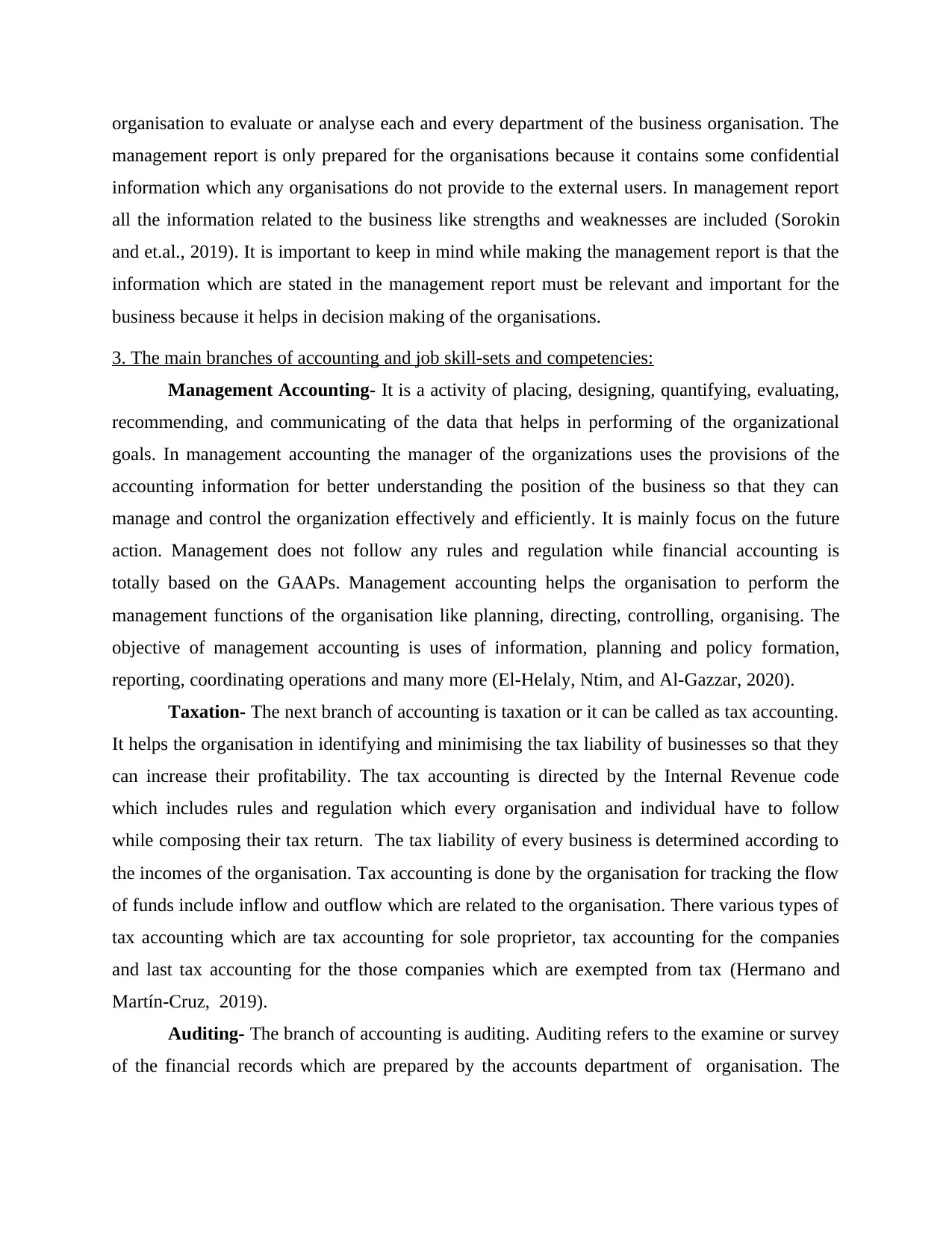
organisation to evaluate or analyse each and every department of the business organisation. The
management report is only prepared for the organisations because it contains some confidential
information which any organisations do not provide to the external users. In management report
all the information related to the business like strengths and weaknesses are included (Sorokin
and et.al., 2019). It is important to keep in mind while making the management report is that the
information which are stated in the management report must be relevant and important for the
business because it helps in decision making of the organisations.
3. The main branches of accounting and job skill-sets and competencies:
Management Accounting- It is a activity of placing, designing, quantifying, evaluating,
recommending, and communicating of the data that helps in performing of the organizational
goals. In management accounting the manager of the organizations uses the provisions of the
accounting information for better understanding the position of the business so that they can
manage and control the organization effectively and efficiently. It is mainly focus on the future
action. Management does not follow any rules and regulation while financial accounting is
totally based on the GAAPs. Management accounting helps the organisation to perform the
management functions of the organisation like planning, directing, controlling, organising. The
objective of management accounting is uses of information, planning and policy formation,
reporting, coordinating operations and many more (El-Helaly, Ntim, and Al-Gazzar, 2020).
Taxation- The next branch of accounting is taxation or it can be called as tax accounting.
It helps the organisation in identifying and minimising the tax liability of businesses so that they
can increase their profitability. The tax accounting is directed by the Internal Revenue code
which includes rules and regulation which every organisation and individual have to follow
while composing their tax return. The tax liability of every business is determined according to
the incomes of the organisation. Tax accounting is done by the organisation for tracking the flow
of funds include inflow and outflow which are related to the organisation. There various types of
tax accounting which are tax accounting for sole proprietor, tax accounting for the companies
and last tax accounting for the those companies which are exempted from tax (Hermano and
Martín-Cruz, 2019).
Auditing- The branch of accounting is auditing. Auditing refers to the examine or survey
of the financial records which are prepared by the accounts department of organisation. The
management report is only prepared for the organisations because it contains some confidential
information which any organisations do not provide to the external users. In management report
all the information related to the business like strengths and weaknesses are included (Sorokin
and et.al., 2019). It is important to keep in mind while making the management report is that the
information which are stated in the management report must be relevant and important for the
business because it helps in decision making of the organisations.
3. The main branches of accounting and job skill-sets and competencies:
Management Accounting- It is a activity of placing, designing, quantifying, evaluating,
recommending, and communicating of the data that helps in performing of the organizational
goals. In management accounting the manager of the organizations uses the provisions of the
accounting information for better understanding the position of the business so that they can
manage and control the organization effectively and efficiently. It is mainly focus on the future
action. Management does not follow any rules and regulation while financial accounting is
totally based on the GAAPs. Management accounting helps the organisation to perform the
management functions of the organisation like planning, directing, controlling, organising. The
objective of management accounting is uses of information, planning and policy formation,
reporting, coordinating operations and many more (El-Helaly, Ntim, and Al-Gazzar, 2020).
Taxation- The next branch of accounting is taxation or it can be called as tax accounting.
It helps the organisation in identifying and minimising the tax liability of businesses so that they
can increase their profitability. The tax accounting is directed by the Internal Revenue code
which includes rules and regulation which every organisation and individual have to follow
while composing their tax return. The tax liability of every business is determined according to
the incomes of the organisation. Tax accounting is done by the organisation for tracking the flow
of funds include inflow and outflow which are related to the organisation. There various types of
tax accounting which are tax accounting for sole proprietor, tax accounting for the companies
and last tax accounting for the those companies which are exempted from tax (Hermano and
Martín-Cruz, 2019).
Auditing- The branch of accounting is auditing. Auditing refers to the examine or survey
of the financial records which are prepared by the accounts department of organisation. The
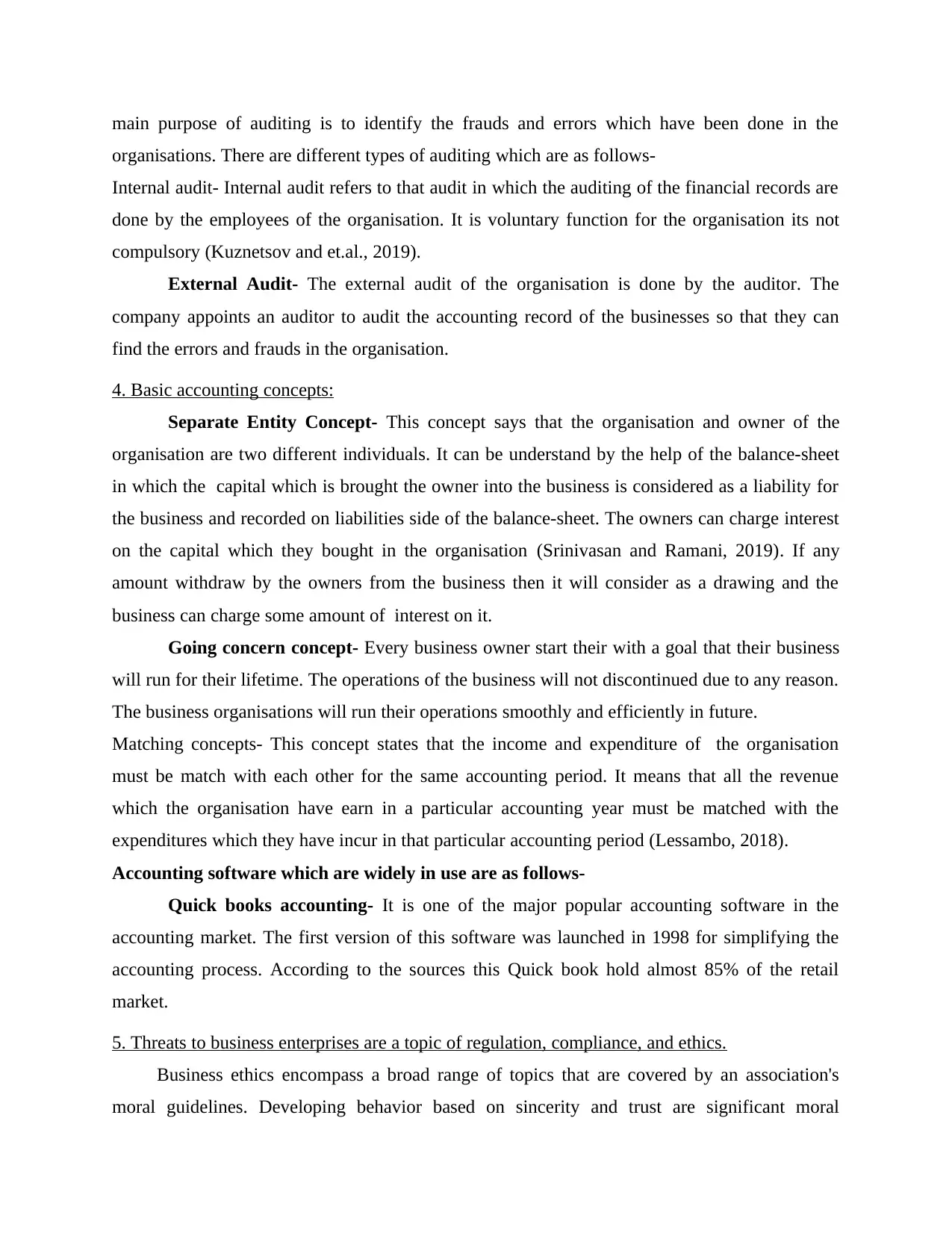
main purpose of auditing is to identify the frauds and errors which have been done in the
organisations. There are different types of auditing which are as follows-
Internal audit- Internal audit refers to that audit in which the auditing of the financial records are
done by the employees of the organisation. It is voluntary function for the organisation its not
compulsory (Kuznetsov and et.al., 2019).
External Audit- The external audit of the organisation is done by the auditor. The
company appoints an auditor to audit the accounting record of the businesses so that they can
find the errors and frauds in the organisation.
4. Basic accounting concepts:
Separate Entity Concept- This concept says that the organisation and owner of the
organisation are two different individuals. It can be understand by the help of the balance-sheet
in which the capital which is brought the owner into the business is considered as a liability for
the business and recorded on liabilities side of the balance-sheet. The owners can charge interest
on the capital which they bought in the organisation (Srinivasan and Ramani, 2019). If any
amount withdraw by the owners from the business then it will consider as a drawing and the
business can charge some amount of interest on it.
Going concern concept- Every business owner start their with a goal that their business
will run for their lifetime. The operations of the business will not discontinued due to any reason.
The business organisations will run their operations smoothly and efficiently in future.
Matching concepts- This concept states that the income and expenditure of the organisation
must be match with each other for the same accounting period. It means that all the revenue
which the organisation have earn in a particular accounting year must be matched with the
expenditures which they have incur in that particular accounting period (Lessambo, 2018).
Accounting software which are widely in use are as follows-
Quick books accounting- It is one of the major popular accounting software in the
accounting market. The first version of this software was launched in 1998 for simplifying the
accounting process. According to the sources this Quick book hold almost 85% of the retail
market.
5. Threats to business enterprises are a topic of regulation, compliance, and ethics.
Business ethics encompass a broad range of topics that are covered by an association's
moral guidelines. Developing behavior based on sincerity and trust are significant moral
organisations. There are different types of auditing which are as follows-
Internal audit- Internal audit refers to that audit in which the auditing of the financial records are
done by the employees of the organisation. It is voluntary function for the organisation its not
compulsory (Kuznetsov and et.al., 2019).
External Audit- The external audit of the organisation is done by the auditor. The
company appoints an auditor to audit the accounting record of the businesses so that they can
find the errors and frauds in the organisation.
4. Basic accounting concepts:
Separate Entity Concept- This concept says that the organisation and owner of the
organisation are two different individuals. It can be understand by the help of the balance-sheet
in which the capital which is brought the owner into the business is considered as a liability for
the business and recorded on liabilities side of the balance-sheet. The owners can charge interest
on the capital which they bought in the organisation (Srinivasan and Ramani, 2019). If any
amount withdraw by the owners from the business then it will consider as a drawing and the
business can charge some amount of interest on it.
Going concern concept- Every business owner start their with a goal that their business
will run for their lifetime. The operations of the business will not discontinued due to any reason.
The business organisations will run their operations smoothly and efficiently in future.
Matching concepts- This concept states that the income and expenditure of the organisation
must be match with each other for the same accounting period. It means that all the revenue
which the organisation have earn in a particular accounting year must be matched with the
expenditures which they have incur in that particular accounting period (Lessambo, 2018).
Accounting software which are widely in use are as follows-
Quick books accounting- It is one of the major popular accounting software in the
accounting market. The first version of this software was launched in 1998 for simplifying the
accounting process. According to the sources this Quick book hold almost 85% of the retail
market.
5. Threats to business enterprises are a topic of regulation, compliance, and ethics.
Business ethics encompass a broad range of topics that are covered by an association's
moral guidelines. Developing behavior based on sincerity and trust are significant moral
⊘ This is a preview!⊘
Do you want full access?
Subscribe today to unlock all pages.

Trusted by 1+ million students worldwide
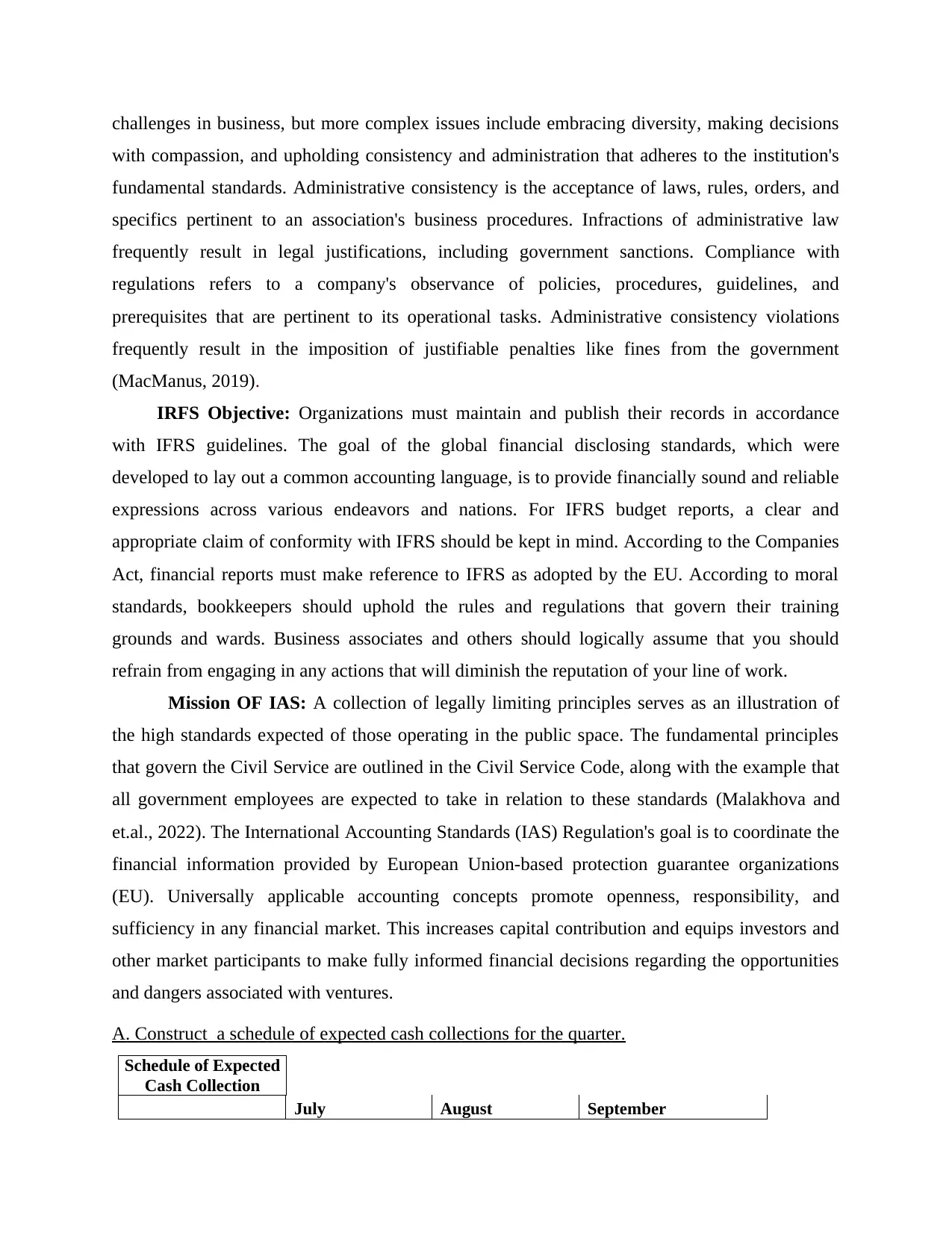
challenges in business, but more complex issues include embracing diversity, making decisions
with compassion, and upholding consistency and administration that adheres to the institution's
fundamental standards. Administrative consistency is the acceptance of laws, rules, orders, and
specifics pertinent to an association's business procedures. Infractions of administrative law
frequently result in legal justifications, including government sanctions. Compliance with
regulations refers to a company's observance of policies, procedures, guidelines, and
prerequisites that are pertinent to its operational tasks. Administrative consistency violations
frequently result in the imposition of justifiable penalties like fines from the government
(MacManus, 2019).
IRFS Objective: Organizations must maintain and publish their records in accordance
with IFRS guidelines. The goal of the global financial disclosing standards, which were
developed to lay out a common accounting language, is to provide financially sound and reliable
expressions across various endeavors and nations. For IFRS budget reports, a clear and
appropriate claim of conformity with IFRS should be kept in mind. According to the Companies
Act, financial reports must make reference to IFRS as adopted by the EU. According to moral
standards, bookkeepers should uphold the rules and regulations that govern their training
grounds and wards. Business associates and others should logically assume that you should
refrain from engaging in any actions that will diminish the reputation of your line of work.
Mission OF IAS: A collection of legally limiting principles serves as an illustration of
the high standards expected of those operating in the public space. The fundamental principles
that govern the Civil Service are outlined in the Civil Service Code, along with the example that
all government employees are expected to take in relation to these standards (Malakhova and
et.al., 2022). The International Accounting Standards (IAS) Regulation's goal is to coordinate the
financial information provided by European Union-based protection guarantee organizations
(EU). Universally applicable accounting concepts promote openness, responsibility, and
sufficiency in any financial market. This increases capital contribution and equips investors and
other market participants to make fully informed financial decisions regarding the opportunities
and dangers associated with ventures.
A. Construct a schedule of expected cash collections for the quarter.
Schedule of Expected
Cash Collection
July August September
with compassion, and upholding consistency and administration that adheres to the institution's
fundamental standards. Administrative consistency is the acceptance of laws, rules, orders, and
specifics pertinent to an association's business procedures. Infractions of administrative law
frequently result in legal justifications, including government sanctions. Compliance with
regulations refers to a company's observance of policies, procedures, guidelines, and
prerequisites that are pertinent to its operational tasks. Administrative consistency violations
frequently result in the imposition of justifiable penalties like fines from the government
(MacManus, 2019).
IRFS Objective: Organizations must maintain and publish their records in accordance
with IFRS guidelines. The goal of the global financial disclosing standards, which were
developed to lay out a common accounting language, is to provide financially sound and reliable
expressions across various endeavors and nations. For IFRS budget reports, a clear and
appropriate claim of conformity with IFRS should be kept in mind. According to the Companies
Act, financial reports must make reference to IFRS as adopted by the EU. According to moral
standards, bookkeepers should uphold the rules and regulations that govern their training
grounds and wards. Business associates and others should logically assume that you should
refrain from engaging in any actions that will diminish the reputation of your line of work.
Mission OF IAS: A collection of legally limiting principles serves as an illustration of
the high standards expected of those operating in the public space. The fundamental principles
that govern the Civil Service are outlined in the Civil Service Code, along with the example that
all government employees are expected to take in relation to these standards (Malakhova and
et.al., 2022). The International Accounting Standards (IAS) Regulation's goal is to coordinate the
financial information provided by European Union-based protection guarantee organizations
(EU). Universally applicable accounting concepts promote openness, responsibility, and
sufficiency in any financial market. This increases capital contribution and equips investors and
other market participants to make fully informed financial decisions regarding the opportunities
and dangers associated with ventures.
A. Construct a schedule of expected cash collections for the quarter.
Schedule of Expected
Cash Collection
July August September
Paraphrase This Document
Need a fresh take? Get an instant paraphrase of this document with our AI Paraphraser
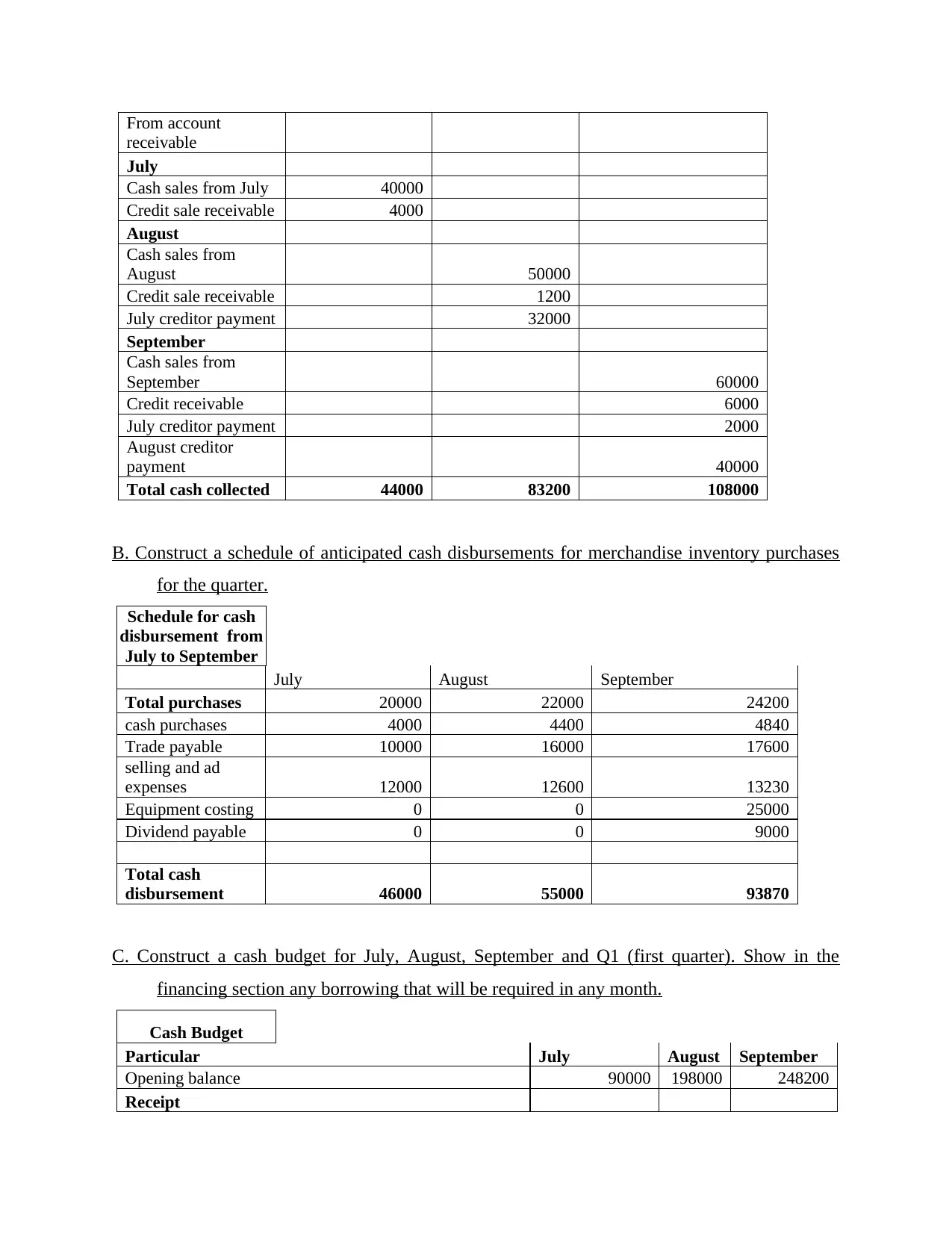
From account
receivable
July
Cash sales from July 40000
Credit sale receivable 4000
August
Cash sales from
August 50000
Credit sale receivable 1200
July creditor payment 32000
September
Cash sales from
September 60000
Credit receivable 6000
July creditor payment 2000
August creditor
payment 40000
Total cash collected 44000 83200 108000
B. Construct a schedule of anticipated cash disbursements for merchandise inventory purchases
for the quarter.
Schedule for cash
disbursement from
July to September
July August September
Total purchases 20000 22000 24200
cash purchases 4000 4400 4840
Trade payable 10000 16000 17600
selling and ad
expenses 12000 12600 13230
Equipment costing 0 0 25000
Dividend payable 0 0 9000
Total cash
disbursement 46000 55000 93870
C. Construct a cash budget for July, August, September and Q1 (first quarter). Show in the
financing section any borrowing that will be required in any month.
Cash Budget
Particular July August September
Opening balance 90000 198000 248200
Receipt
receivable
July
Cash sales from July 40000
Credit sale receivable 4000
August
Cash sales from
August 50000
Credit sale receivable 1200
July creditor payment 32000
September
Cash sales from
September 60000
Credit receivable 6000
July creditor payment 2000
August creditor
payment 40000
Total cash collected 44000 83200 108000
B. Construct a schedule of anticipated cash disbursements for merchandise inventory purchases
for the quarter.
Schedule for cash
disbursement from
July to September
July August September
Total purchases 20000 22000 24200
cash purchases 4000 4400 4840
Trade payable 10000 16000 17600
selling and ad
expenses 12000 12600 13230
Equipment costing 0 0 25000
Dividend payable 0 0 9000
Total cash
disbursement 46000 55000 93870
C. Construct a cash budget for July, August, September and Q1 (first quarter). Show in the
financing section any borrowing that will be required in any month.
Cash Budget
Particular July August September
Opening balance 90000 198000 248200
Receipt
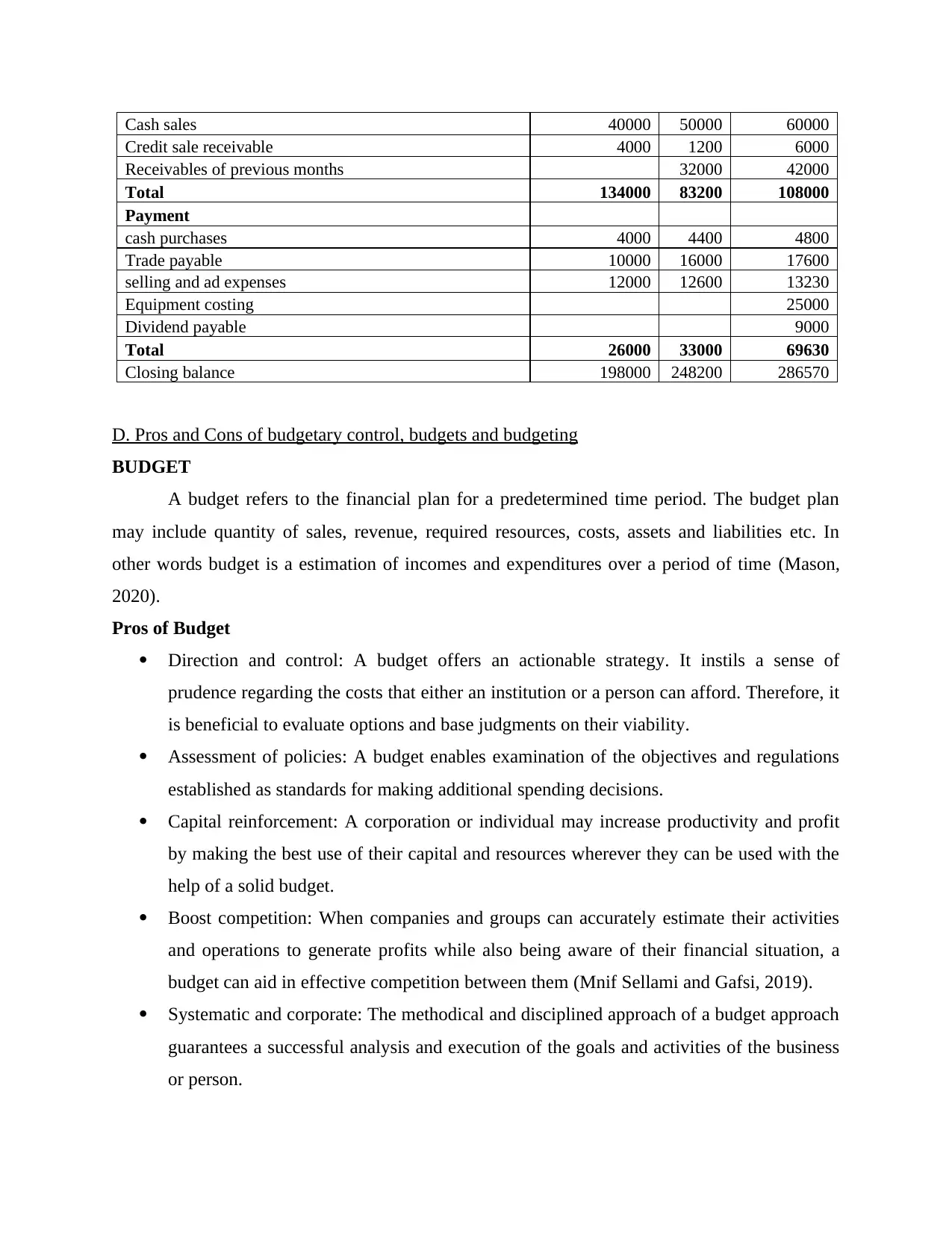
Cash sales 40000 50000 60000
Credit sale receivable 4000 1200 6000
Receivables of previous months 32000 42000
Total 134000 83200 108000
Payment
cash purchases 4000 4400 4800
Trade payable 10000 16000 17600
selling and ad expenses 12000 12600 13230
Equipment costing 25000
Dividend payable 9000
Total 26000 33000 69630
Closing balance 198000 248200 286570
D. Pros and Cons of budgetary control, budgets and budgeting
BUDGET
A budget refers to the financial plan for a predetermined time period. The budget plan
may include quantity of sales, revenue, required resources, costs, assets and liabilities etc. In
other words budget is a estimation of incomes and expenditures over a period of time (Mason,
2020).
Pros of Budget
Direction and control: A budget offers an actionable strategy. It instils a sense of
prudence regarding the costs that either an institution or a person can afford. Therefore, it
is beneficial to evaluate options and base judgments on their viability.
Assessment of policies: A budget enables examination of the objectives and regulations
established as standards for making additional spending decisions.
Capital reinforcement: A corporation or individual may increase productivity and profit
by making the best use of their capital and resources wherever they can be used with the
help of a solid budget.
Boost competition: When companies and groups can accurately estimate their activities
and operations to generate profits while also being aware of their financial situation, a
budget can aid in effective competition between them (Mnif Sellami and Gafsi, 2019).
Systematic and corporate: The methodical and disciplined approach of a budget approach
guarantees a successful analysis and execution of the goals and activities of the business
or person.
Credit sale receivable 4000 1200 6000
Receivables of previous months 32000 42000
Total 134000 83200 108000
Payment
cash purchases 4000 4400 4800
Trade payable 10000 16000 17600
selling and ad expenses 12000 12600 13230
Equipment costing 25000
Dividend payable 9000
Total 26000 33000 69630
Closing balance 198000 248200 286570
D. Pros and Cons of budgetary control, budgets and budgeting
BUDGET
A budget refers to the financial plan for a predetermined time period. The budget plan
may include quantity of sales, revenue, required resources, costs, assets and liabilities etc. In
other words budget is a estimation of incomes and expenditures over a period of time (Mason,
2020).
Pros of Budget
Direction and control: A budget offers an actionable strategy. It instils a sense of
prudence regarding the costs that either an institution or a person can afford. Therefore, it
is beneficial to evaluate options and base judgments on their viability.
Assessment of policies: A budget enables examination of the objectives and regulations
established as standards for making additional spending decisions.
Capital reinforcement: A corporation or individual may increase productivity and profit
by making the best use of their capital and resources wherever they can be used with the
help of a solid budget.
Boost competition: When companies and groups can accurately estimate their activities
and operations to generate profits while also being aware of their financial situation, a
budget can aid in effective competition between them (Mnif Sellami and Gafsi, 2019).
Systematic and corporate: The methodical and disciplined approach of a budget approach
guarantees a successful analysis and execution of the goals and activities of the business
or person.
⊘ This is a preview!⊘
Do you want full access?
Subscribe today to unlock all pages.

Trusted by 1+ million students worldwide

Formative: A budget establishes guidelines to be followed so that resources and money
are used effectively, preventing any of them from being squandered.
Cons of budget
Unfaithful and unrealistic: Assumptions and conclusions form the basis of a budget. The
whole forecast across the budget plan will be impacted by any changes to the business
strategy or execution. As a result, the outcomes of a financial plan are never certain and
occasionally unreliable (Mnif and Gafsi, 2020).
Inflexible: A budget is created based on certain institutional regulations or personal goals
that influence decision-making. The budget, however, cannot be changed if there is a
need to assess the financial situation in light of market fluctuations.
Fund oriented: The interests and needs of the people are not supported by the budget.
While the requirements of the people are more qualitative in nature, it is more profit-
oriented, which is more quantitative..
Time-consuming: The method of creating a budget Or creating a budget takes a lot of
time. Before committing to any investment or spending toward a certain aim, it must take
into account all relevant factors pertaining to a company or a person.
Conflicts: Failure of a proposed budget can lead to numerous internal conflicts and rifts,
which finally manifest themselves in the organization's ineffective management.
BUDGETARY CONTROL
It refers to the financial process for controlling incomes and expenditures of a certain
period of time. In this process, manager regularly compare the actual income and expenditure to
the budgeted income and expenditures to measure the deficiencies. It also help firm to measure
the requirement of needful actions to overcome from the deficiencies (Pfiffner, 2019).
Pros of Budgetary Control
It states the objectives, plans and policies of the company. When there is no
predetermined goal and aim then the contribution and efforts will be wasted in the
success of budget.
It determines the targets for every department and they are forced to to their job
according to their target. It plays important role in managing activities of every
department and reduces the possibilities of conflicts.
are used effectively, preventing any of them from being squandered.
Cons of budget
Unfaithful and unrealistic: Assumptions and conclusions form the basis of a budget. The
whole forecast across the budget plan will be impacted by any changes to the business
strategy or execution. As a result, the outcomes of a financial plan are never certain and
occasionally unreliable (Mnif and Gafsi, 2020).
Inflexible: A budget is created based on certain institutional regulations or personal goals
that influence decision-making. The budget, however, cannot be changed if there is a
need to assess the financial situation in light of market fluctuations.
Fund oriented: The interests and needs of the people are not supported by the budget.
While the requirements of the people are more qualitative in nature, it is more profit-
oriented, which is more quantitative..
Time-consuming: The method of creating a budget Or creating a budget takes a lot of
time. Before committing to any investment or spending toward a certain aim, it must take
into account all relevant factors pertaining to a company or a person.
Conflicts: Failure of a proposed budget can lead to numerous internal conflicts and rifts,
which finally manifest themselves in the organization's ineffective management.
BUDGETARY CONTROL
It refers to the financial process for controlling incomes and expenditures of a certain
period of time. In this process, manager regularly compare the actual income and expenditure to
the budgeted income and expenditures to measure the deficiencies. It also help firm to measure
the requirement of needful actions to overcome from the deficiencies (Pfiffner, 2019).
Pros of Budgetary Control
It states the objectives, plans and policies of the company. When there is no
predetermined goal and aim then the contribution and efforts will be wasted in the
success of budget.
It determines the targets for every department and they are forced to to their job
according to their target. It plays important role in managing activities of every
department and reduces the possibilities of conflicts.
Paraphrase This Document
Need a fresh take? Get an instant paraphrase of this document with our AI Paraphraser
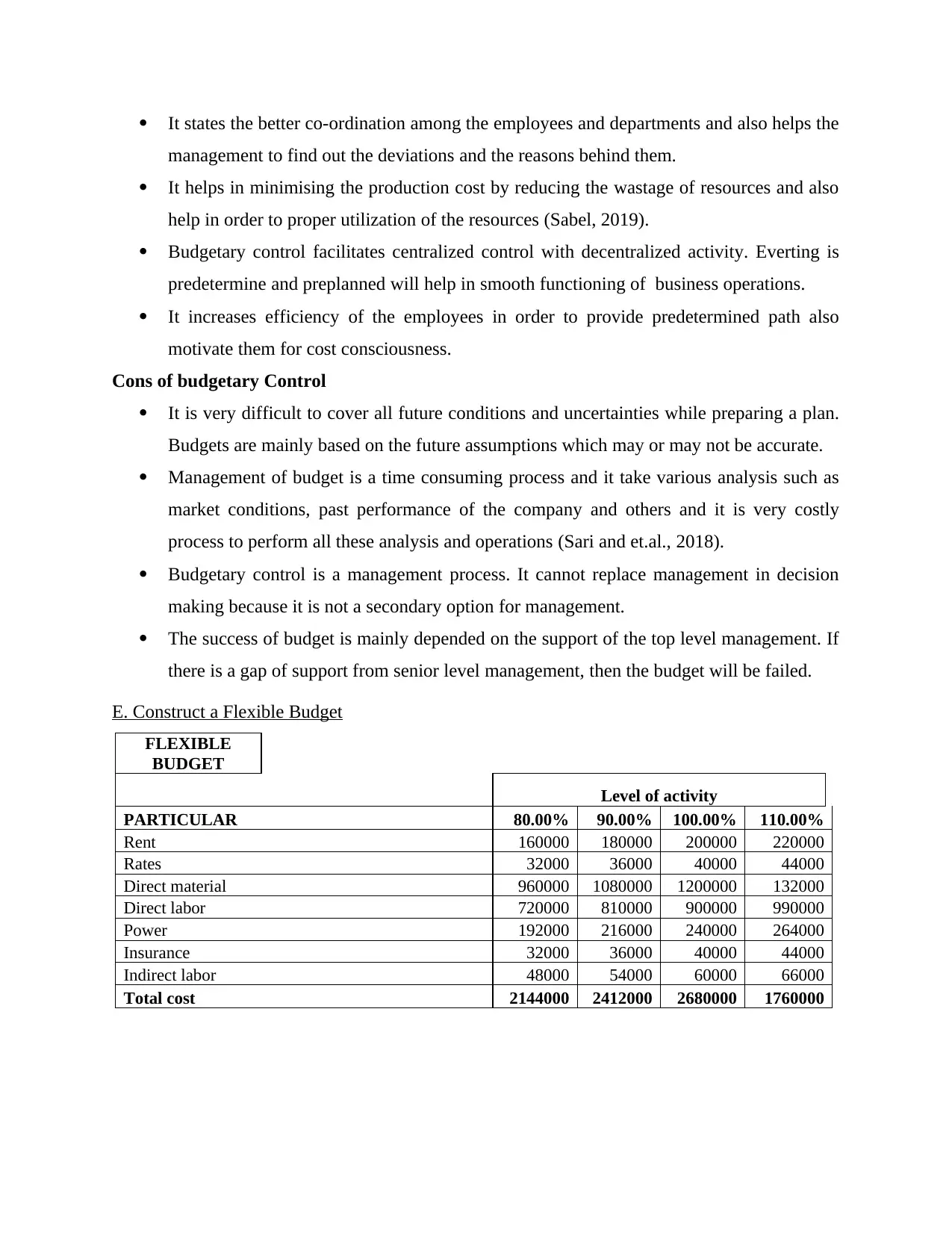
It states the better co-ordination among the employees and departments and also helps the
management to find out the deviations and the reasons behind them.
It helps in minimising the production cost by reducing the wastage of resources and also
help in order to proper utilization of the resources (Sabel, 2019).
Budgetary control facilitates centralized control with decentralized activity. Everting is
predetermine and preplanned will help in smooth functioning of business operations.
It increases efficiency of the employees in order to provide predetermined path also
motivate them for cost consciousness.
Cons of budgetary Control
It is very difficult to cover all future conditions and uncertainties while preparing a plan.
Budgets are mainly based on the future assumptions which may or may not be accurate.
Management of budget is a time consuming process and it take various analysis such as
market conditions, past performance of the company and others and it is very costly
process to perform all these analysis and operations (Sari and et.al., 2018).
Budgetary control is a management process. It cannot replace management in decision
making because it is not a secondary option for management.
The success of budget is mainly depended on the support of the top level management. If
there is a gap of support from senior level management, then the budget will be failed.
E. Construct a Flexible Budget
FLEXIBLE
BUDGET
Level of activity
PARTICULAR 80.00% 90.00% 100.00% 110.00%
Rent 160000 180000 200000 220000
Rates 32000 36000 40000 44000
Direct material 960000 1080000 1200000 132000
Direct labor 720000 810000 900000 990000
Power 192000 216000 240000 264000
Insurance 32000 36000 40000 44000
Indirect labor 48000 54000 60000 66000
Total cost 2144000 2412000 2680000 1760000
management to find out the deviations and the reasons behind them.
It helps in minimising the production cost by reducing the wastage of resources and also
help in order to proper utilization of the resources (Sabel, 2019).
Budgetary control facilitates centralized control with decentralized activity. Everting is
predetermine and preplanned will help in smooth functioning of business operations.
It increases efficiency of the employees in order to provide predetermined path also
motivate them for cost consciousness.
Cons of budgetary Control
It is very difficult to cover all future conditions and uncertainties while preparing a plan.
Budgets are mainly based on the future assumptions which may or may not be accurate.
Management of budget is a time consuming process and it take various analysis such as
market conditions, past performance of the company and others and it is very costly
process to perform all these analysis and operations (Sari and et.al., 2018).
Budgetary control is a management process. It cannot replace management in decision
making because it is not a secondary option for management.
The success of budget is mainly depended on the support of the top level management. If
there is a gap of support from senior level management, then the budget will be failed.
E. Construct a Flexible Budget
FLEXIBLE
BUDGET
Level of activity
PARTICULAR 80.00% 90.00% 100.00% 110.00%
Rent 160000 180000 200000 220000
Rates 32000 36000 40000 44000
Direct material 960000 1080000 1200000 132000
Direct labor 720000 810000 900000 990000
Power 192000 216000 240000 264000
Insurance 32000 36000 40000 44000
Indirect labor 48000 54000 60000 66000
Total cost 2144000 2412000 2680000 1760000
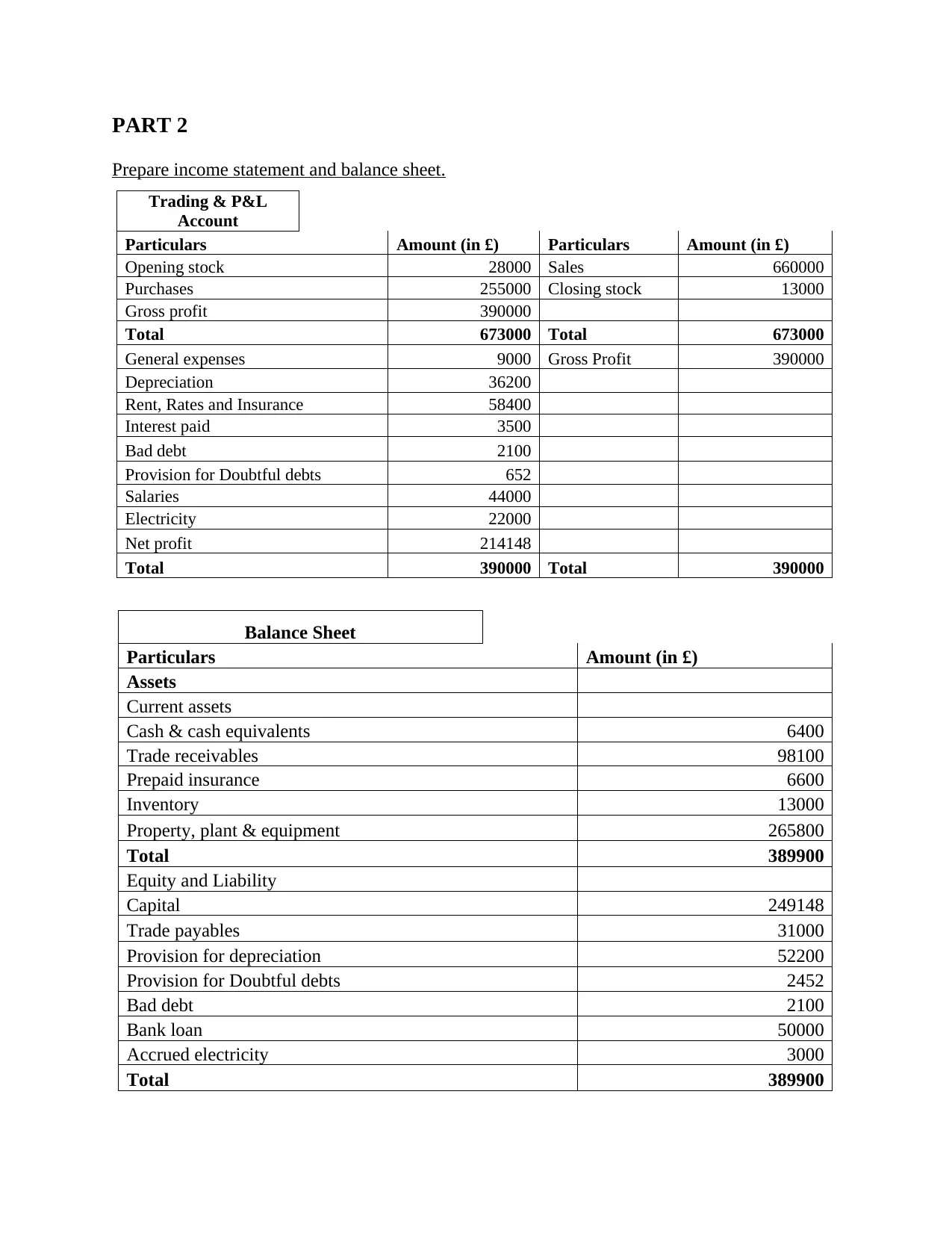
PART 2
Prepare income statement and balance sheet.
Trading & P&L
Account
Particulars Amount (in £) Particulars Amount (in £)
Opening stock 28000 Sales 660000
Purchases 255000 Closing stock 13000
Gross profit 390000
Total 673000 Total 673000
General expenses 9000 Gross Profit 390000
Depreciation 36200
Rent, Rates and Insurance 58400
Interest paid 3500
Bad debt 2100
Provision for Doubtful debts 652
Salaries 44000
Electricity 22000
Net profit 214148
Total 390000 Total 390000
Balance Sheet
Particulars Amount (in £)
Assets
Current assets
Cash & cash equivalents 6400
Trade receivables 98100
Prepaid insurance 6600
Inventory 13000
Property, plant & equipment 265800
Total 389900
Equity and Liability
Capital 249148
Trade payables 31000
Provision for depreciation 52200
Provision for Doubtful debts 2452
Bad debt 2100
Bank loan 50000
Accrued electricity 3000
Total 389900
Prepare income statement and balance sheet.
Trading & P&L
Account
Particulars Amount (in £) Particulars Amount (in £)
Opening stock 28000 Sales 660000
Purchases 255000 Closing stock 13000
Gross profit 390000
Total 673000 Total 673000
General expenses 9000 Gross Profit 390000
Depreciation 36200
Rent, Rates and Insurance 58400
Interest paid 3500
Bad debt 2100
Provision for Doubtful debts 652
Salaries 44000
Electricity 22000
Net profit 214148
Total 390000 Total 390000
Balance Sheet
Particulars Amount (in £)
Assets
Current assets
Cash & cash equivalents 6400
Trade receivables 98100
Prepaid insurance 6600
Inventory 13000
Property, plant & equipment 265800
Total 389900
Equity and Liability
Capital 249148
Trade payables 31000
Provision for depreciation 52200
Provision for Doubtful debts 2452
Bad debt 2100
Bank loan 50000
Accrued electricity 3000
Total 389900
⊘ This is a preview!⊘
Do you want full access?
Subscribe today to unlock all pages.

Trusted by 1+ million students worldwide
1 out of 17